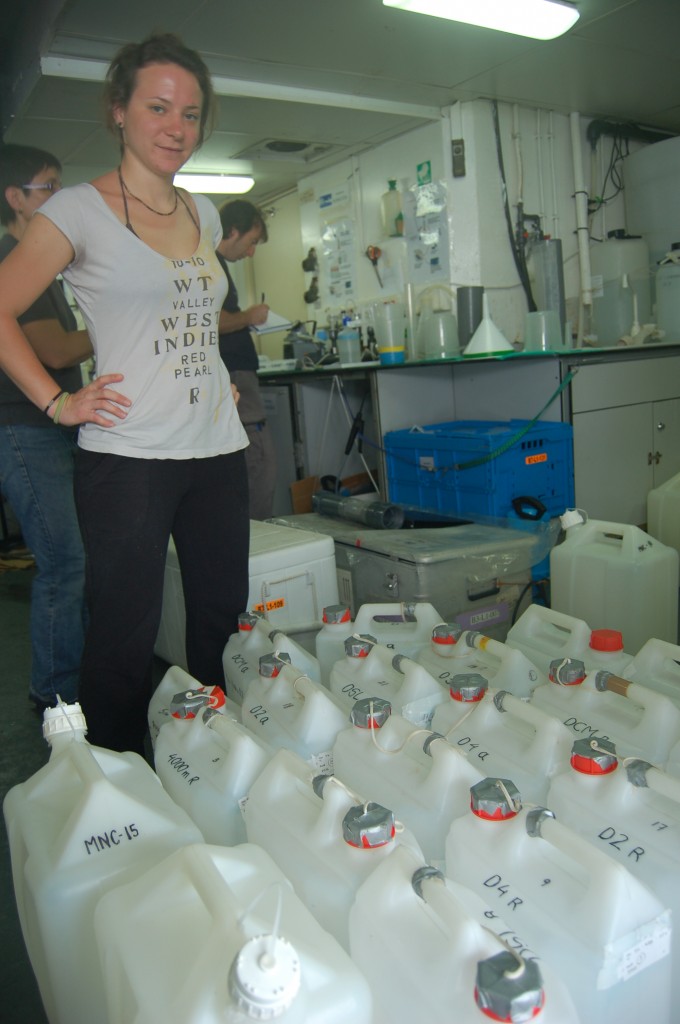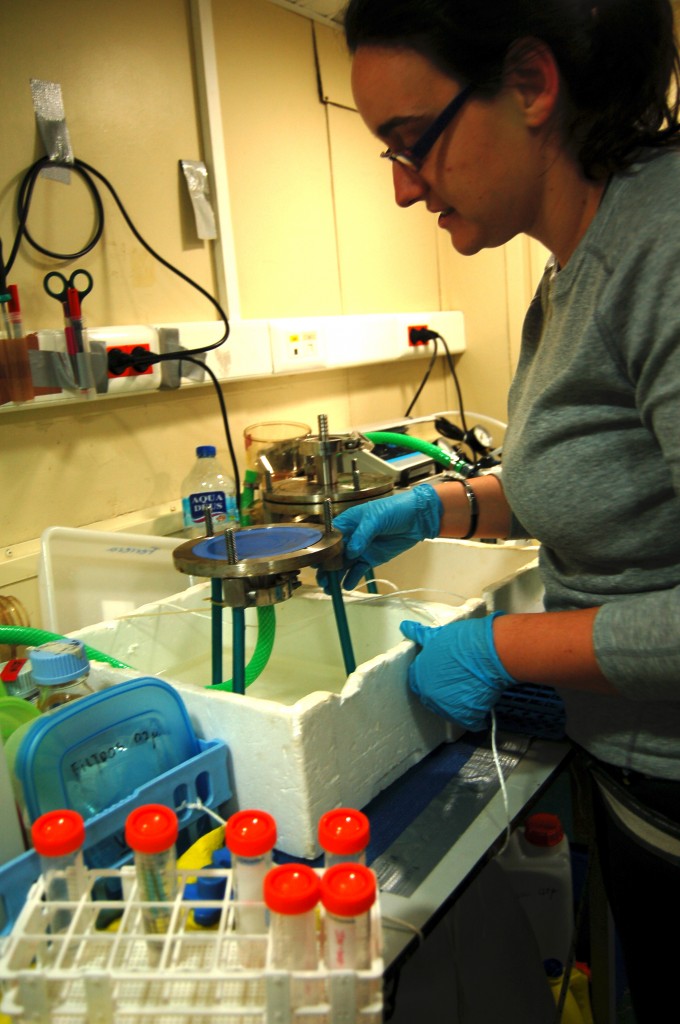S 29° 33 15″ E 72° 26’ 25″ – The sun returned to the Hespérides Saturday. Scientists sprawled on the flight deck after lunch, indulging in short siestas or playing a little foosball in the hangar. Just before 3pm, an alarm clock rang and one of the researchers sprang up to check on a filter running downstairs in the laboratory. The microbes were waiting.
Now that the seas are calmer, the researchers onboard have their hands full again with sampling and filtering and storing data. In the sunless laboratory below decks Encarna Borrull Francesch, a graduate student at the CSIC’s Institute for Marine Sciences in Barcelona, plugs in a device that looks like a cross between a solar panel and a small stool. The disk is a filter, she explains, which she can tune depending on what she wants to extract from the water. Today, it is viruses.
A green hose feeds the spindly device from a white jug on the ground. The water sloshing around inside came up that morning from 4,000 metres below the ship. The water doesn’t look special, but the filter will capture bacteria, says Borrull. Then another hose takes the water through an even finer filter, about 0.2 micrometres, which will let through only viruses. Borrull adds ferric chloride to the water that emerges. The compound traps the viruses, making it possible to filter the combined globules out of the water and transport them home for analysis.
The DNA from the bacteria will help researchers identify what microbes are living at 4,000 metres deep. The RNA will tell them which genetic instructions were being carried out at the time the sample was taken.
 Other cruises have examined the genomes of marine microbes, such as the J. Craig Venter Institute’s Global Ocean Sampling expedition. And Malaspina collaborators have studied coastal waters. But by comparison to the Malaspina expedition, those are just scratching the surface of the ocean’s genome. The material Borrull and colleagues are collecting comes from much deeper, a little-known region of cold water, no light, and fertilized with marine snow, the organic detritus of the upper ocean.
Other cruises have examined the genomes of marine microbes, such as the J. Craig Venter Institute’s Global Ocean Sampling expedition. And Malaspina collaborators have studied coastal waters. But by comparison to the Malaspina expedition, those are just scratching the surface of the ocean’s genome. The material Borrull and colleagues are collecting comes from much deeper, a little-known region of cold water, no light, and fertilized with marine snow, the organic detritus of the upper ocean.
In a neighboring laboratory Kerstin Olbrich, a graduate student at the University of Vienna, collects a dozen jugs of water. She and her colleague Eva Sintes Elvelin, a microbial ecologist at the University of Vienna, will also be grabbing cells from the deep waters of the Indian Ocean. Back on land, they will break open the cells and identify the proteins which the cells contain. The genetic instructions measured by Borrull tell the cells which proteins to make but measuring the actual proteins provides a glimpse of cellular activity at a slightly later stage in the process.
“We don’t know what we’ll find,” says Sintes, since the field of marine proteomics is still brand new. They will compare the proteins they find with a database of proteins whose functions scientists think they understand. If the team find any matches, they may be able to work out some of the cellular activity of these open ocean bacteria. “We could compare them to coastal bacteria,” Sintes says, “but mostly we’ll be describing them.”
The exploration is not targeted toward any particular type of species or cellular activity; it’s a survey designed to raise questions rather than answer them. “We’re not really testing a hypothesis here,” Sintes says, “We’re looking to see what we find. Maybe later there will be hypotheses.”
Previous posts in this series:
Malaspina expedition: Catching our breath (24 February 2011)
Malaspina expedition: Data deluge (21 February 2011)
Malaspina expedition: Water, water everywhere and not a drop to sample (17 February 2011)
Malaspina expedition: Starting out with a splash (14 February 2011)
Malaspina expedition: Shipping out (11 February 2011)
Images: Encarna Borrull Francesch of the CSIC’s Institute for Marine Sciences in Barcelona filters deep sea water (top); Kerstin Olbrich of the University of Vienna stands guard over her samples. / Lucas Laursen. Map indicates approximate location of dispatches.
First published on Nature’s The Great Beyond blog: [html]
